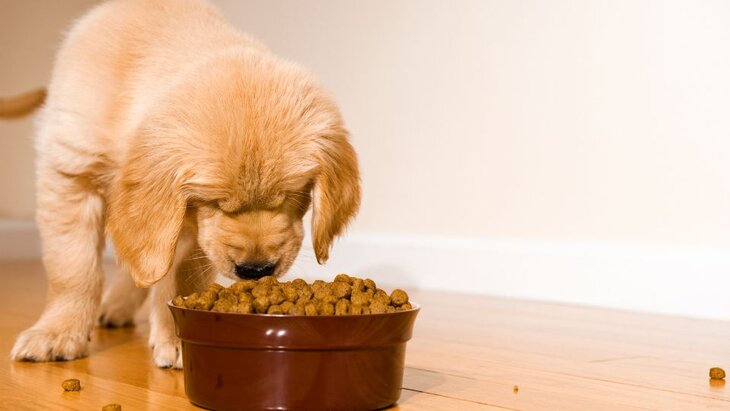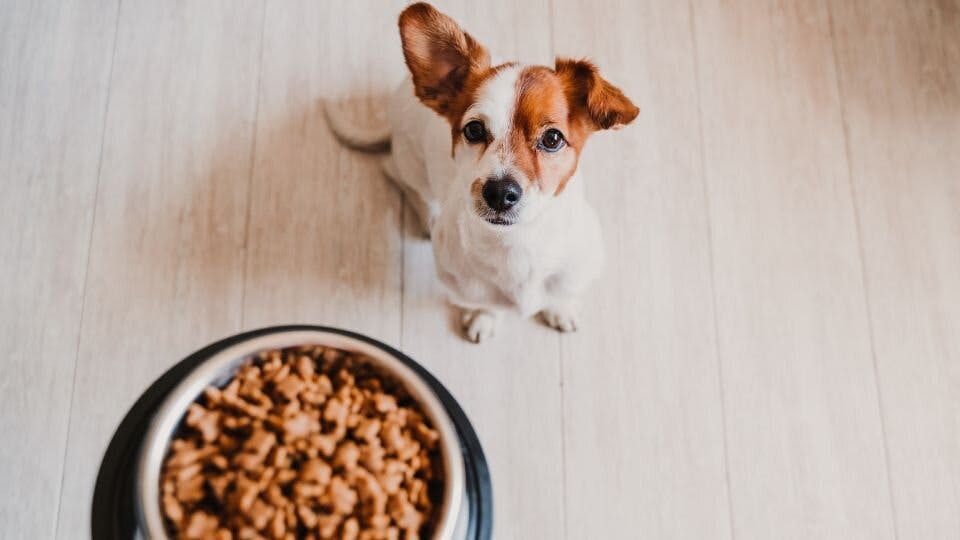How Much To Feed A Puppy: Chart By Weight & Age
Nutrition and diet are crucial for optimal health at every stage of your pet’s life, but especially during their early stages of development. Learning how much to feed a puppy and how often to feed a puppy can significantly impact their growth and behavior for years to come.
Some people can predict the future.
For everyone else, there's pet insurance.
Looking to save on vet bills? See which pet insurance is right for you.
Instant results. 1M+ pet parents served.
⭐⭐⭐⭐⭐ 4.9 stars across hundreds of reviews.
To help you dial in the perfectly sized proportions for your pet, we made a puppy feeding chart that you can easily reference for quick serving suggestions. Our guide also includes answers to common questions that new puppy owners often ask me in the vet office
Let's dive in:
Puppy Feeding Chart: Weight & Age
Estimated Weight at Maturity | 1.5 - 3 months | 4 - 5 months | 6 - 8 months | 9 - 11 months | 1 - 2 years |
|---|---|---|---|---|---|
3-12 lb | ½ to 1 cup | ⅔ to 1⅓ cups | ½ to 1½ cups | Feed as Adult | Feed as Adult |
13-20 lb | ½ to 1¼ cups | 1⅛ to 2 cups | ¾ to 1⅓ cups | ½ to 1½ cups | Feed as Adult |
21-50 lb | ½ to 1½ cups | 1½ to 2¾ cups | 1⅛ to 2⅓ cups | 2 to 3 cups | 2 to 4¼ cups |
51-75 lb | ⅝ to 2⅓ cups | 1½ to 4 cups | 1½ to 3¾ cups | 2½ to 4¾ cups | 2⅝ to 6¼ cups |
76-100 lb | 1 to 2⅔ cups | 2⅞ to 3¾ cups | 2⅞ to 6⅓ cups | 3⅞ to 7 cups | 5⅝ to 11 cups |
101+ lb | 2⅔ cups + ⅓ cup for each 10 lbs of body weight over 100 lbs | 3¾ cups + ⅓ cup for each 10 lbs of body weight over 100 lbs | 6⅓ cups + ⅓ cup for each 10 lbs of body weight over 100 lbs | 7 cups + ⅓ cup for each 10 lbs of body weight over 100 lbs | 11 cups + ⅓ cup for each 10 lbs of body weight over 100 lbs |
*The figures displayed in our puppy feeding chart are meant to be used as estimates. There is no way to recommend the exact amount of food to give a puppy, as they all have different nutritional needs and the suggested serving size varies by each food manufacturer. Consult your veterinarian for the best advice on how much to feed puppies.
How Much Should I Feed My Puppy?
As a general rule of thumb, you should aim to feed a puppy about five to six percent of his or her estimated body weight in adulthood each day. As they get older, the amount of food should be reduced to two to three percent of their body weight in accordance with their nutritional needs.
- Growing puppies: 5-6% of their predicted weight in adulthood
- Underweight or high-energy dogs: 3% of their body weight
- Overweight dogs: 2% of their body weight
5-6%
the percentage of mature body weight a puppy should consume daily
Calculating How Much to Feed a Puppy by Weight
If you're not sure about how much food to give a puppy, you can calculate the ideal amount in a few, simple steps.
- First, measure how much your dog weighs in pounds.
- Then, multiply that number by 16 to calculate their weight in ounces.
- Finally, find 5 to 6 percent of that value to see how much food to give your puppy.
Pro Tip: Weighing your puppy is easy! Simply weigh yourself, then stand on a scale while holding your puppy. Subtract your weight from the total, and voila — you know your puppy’s weight!
Keep in mind that the amount of food your puppy needs will depend on its weight at maturity, so larger dogs will require more food when they’re young. For instance, a German Shepherd will weigh more as an adult than a Maltese and should be fed accordingly.
All puppies are different, so if you have any questions or concerns regarding your puppy’s diet, be sure to talk to your vet.
When Do Puppies Start Eating Food?
Puppies need to start eating complete and balanced puppy food as soon as they are weaned, which usually starts around five weeks old and ends between six to eight weeks old. Small-breed dogs should eat unmoistened dry food by 12 to 13 weeks, and large-breed dogs by nine to 10 weeks.

How Many Calories Should My Puppy Eat?
Like all living beings, dogs need a certain amount of calories to perform vital bodily functions. This is called their "resting energy requirement" (RER), expressed as kilocalories (kcals) . Vets use a specific formula to calculate a dog's RER:1
Resting Energy Requirement (kcals) = (70 x Bodyweight in kg)0.75
To calculate the target number of calories for a puppy, adjust the formula as follows.
- From birth to half-mature weight: RER x 2.2
- From half-mature weight to full maturity: RER x 1.5
Pro Tip: Divide your puppy's weight in pounds by 2.2 to find their weight in kilograms.
The output of this calculation shows you how many kcals your pet needs to satisfy their RER on a daily basis. Use it to determine how much food to give your puppy based on the number of kcals per cup or per ounce, as indicated on the nutrition label of the kibble. You can also refer to the manufacturer's recommended serving sizes, which can vary by formula.
Does Puppy Food Have More Calories?
Yes, puppy food is usually higher in calories and protein because they require more energy to fuel their growth in development, especially during the first five months of life. In fact, young puppies need double the amount of food as an adult dog of the same size just to move, grow, and digest food!
2x
the amount of calories puppies need compared to an adult dog of the same size
How Often Should You Feed a Puppy?
How often to feed a puppy need to eat depends on their stage of development.
- 4-12 weeks: Puppies need three to four meals throughout the day in order to meet their nutritional needs.
- 12 weeks and older: As your puppy matures and their resting energy requirement decreases, reduce the number of meals to two per day. In general, large-breed dogs can make the switch at 12 to 14 weeks, while smaller breeds should drop the third serving around seven to nine weeks old.
Setting a routine for your dog’s feeding schedule will not only benefit their metabolism but also teaches them when to expect their food. Below, is an example of a puppy feeding schedule you can implement at home with approval from your vet.
Puppy Feeding Schedule
Age | Morning | Afternoon | Evening |
|---|---|---|---|
8 weeks old | 7 AM (⅓ daily kcals) | noon (⅓ daily kcals) | 5 PM (⅓ daily kcals) |
12 weeks old | 7 AM (½ daily kcals) | 5 PM (½ daily kcals) |
Note: Small and toy breed puppies are susceptible to hypoglycemia, or low blood sugar, and may therefore require a snack between feedings as recommended by your vet.
What Should I Feed My Puppy?
When puppies first begin weaning and still occasionally nurse off their mother, you should serve commercial-grade kibble softened with a bit of water. By four months old, they should be completely transitioned to a high-quality kibble formulated for puppies.
Be sure to avoid serving raw meat for dogs at this age because puppies have a weakened immune system and can become very ill from exposure to bacteria such as Salmonella, which is commonly found in uncooked food. Additionally, as you begin working on obedience training your puppy, be mindful to choose healthy, low-calorie treats to avoid overfeeding your four-legged friend.
Can Puppies Eat Adult Dog Food?
No, puppies should be fed a complete and balanced diet comprised of ingredients that have been carefully chosen to meet their nutritional needs. These formulas are specifically designed to support the rapid growth and development that young dogs experience, which differs significantly from the nutritional needs of adult dogs.
Why Puppies Need Special Food
Feeding puppies a diet formulated for their growth and development is crucial for their overall health, well-being, and transition into healthy adulthood. Here are a few key differences between puppy food vs dog food:
- Higher Caloric Content: Puppies have a higher metabolic rate and are more active, requiring more calories per pound of body weight than adult dogs to support their growth and energy needs.
- Vitamins and Minerals: Puppy food contains higher levels of vitamins and minerals such as calcium and phosphorus that puppies need for proper bone development and growth.
- Protein Content: Puppy formulas typically have a higher protein content to support muscle growth and development.
- Fat Content: Higher fat content in puppy food provides the energy young dogs need for their active lifestyles and development.
- DHA and Other Nutrients: DHA (Docosahexaenoic Acid), an omega-3 fatty acid important for brain and vision development, is often added to puppy formulas.
Can Adult Dogs Eat Puppy Food?
It's not recommended to serve puppy food to adult dogs because the ingredients in those formulas typically contain a larger amount of calories, protein, and fat than a dog requires after they reach maturity. Continued consumption of puppy food in adult dogs can lead to weight gain and obesity, as well as orthopedic conditions in older pets.

How Long to Feed Puppy Food
Dogs should eat food specially formulated for puppies' developmental needs until they stop growing, which usually takes between 10 and 18 months depending on the size of their breed.
Smaller breeds tend to mature more quickly, sometimes as early as 10 months old. Medium-sized dog breeds weighing between 30 and 60 pounds mature between 12 to 16 months old, while large breeds may require 18 months. Given this longer growth period, it's crucial to provide appropriate nutrition, such as specialized dog food for large breed puppies. Giant breeds can continue growing for over two years.
When to Transition Puppies to Adult Dog Food
Size | Small Dog Breeds up to 30 lb | Medium Dog Breeds 30-60 lb | Large Dog Breeds 60-100 lb | Giant Dog Breeds 100+ lb |
|---|---|---|---|---|
Age | 10-12 mo | 12-16 mo | 16-18 mo | 18-24 mo |
Some vets may recommend switching from puppy food to adult dog food after your pet is spayed or neutered, which also occurs around this time, thereby lowering your pet's energy requirement.
Monitoring How Much Food to Give Your Puppy
You generally don't need to worry about overfeeding puppies until they are about six months old, but it's important to monitor their weight gain. Puppies should grow between 10 to 15% of their body weight per day, which ranges from about 0.5 ounces to 2.5 pounds per week. If your puppy is losing weight versus gaining weight, it may be a sign of a medical condition that requires your vet's attention.
As puppies get older, it's crucial for both you and your vet to keep an eye on their body condition score to determine whether their feeding schedule needs adjustment to minimize the risk of obesity — the number one health problem for pets in the U.S. Generally speaking, dogs with an ideal body condition score should have an observable tuck at the waist with ribs visible beneath a thin layer of fat around the torso.
How Much is Dog Food For Puppies?
A bag of puppy food can cost between $20 and $80 depending on the manufacturing brand, formula ingredients, and size of the bag. Pet owners are estimated to spend between $250 and $700 on dog food per year.
Food is only one cost category for pet owners. You also need to factor in things like toys, supplies, and, most importantly, the cost of vet visits. Young dogs generally visit the vet more often than adults so they for deworming and puppy shots. They also tend to get into things that may make them sick and experience accidents more frequently than adult dogs as they learn to navigate their world.
All factors considered, the cost of owning a puppy in the first year alone is between $740 and $1,325 for small- to medium-sized dogs and $1,020 to $1,825 for larger breeds that require more food as a puppy.2
$740 - $1,825
first-year cost of owning a puppy
How to Save on Pet Care
Pet insurance can be a great way to help cover the cost of vet bills, and supplemental wellness plans can offset the cost of your pet's preventive care. Some, but not all, providers cover the cost of exam fees and regular checkups, and some plans may do a better job at covering conditions that your puppy's breed may be prone to.
Use Pawlicy Advisor to get a personalized pet insurance recommendation based on your unique pet to find a plan with great coverage at an excellent price. Instantly compare quotes from the industry's best pet insurance companies to discover the right option for your needs and enroll within minutes.
References
- Purina, "ERC Calculations Sheet"
- AKC, "The Cost of Puppy's First Year"
Do you want to find the best pet insurance?
Let's analyze your pet's breed, age, and location to find the right coverage and the best savings. Ready?
Analyze My PetAbout Pawlicy Advisor
The pet insurance marketplace endorsed by veterinarians, at Pawlicy Advisor we make buying the best pet insurance easier. By comparing personalized coverage and pricing differences we can save you a ton of money, up to 83% in some instances!
Instantly Compare Pet Insurance Plans
Guides
Determine If Pet Insurance Is Worth It
Comparison Charts
Find Your State
Dog Insurance
DVM
Ricky Walther, DVM, is a small animal general practitioner in the greater Sacramento, California area. Realizing the positive financial and medical impact that pet insurance can provide for pet parents and the profession, he lends support and advice to companies like Pawlicy Advisor "The Pet Insurance Marketplace") that simplify the process of connecting with veterinary financing resources.
